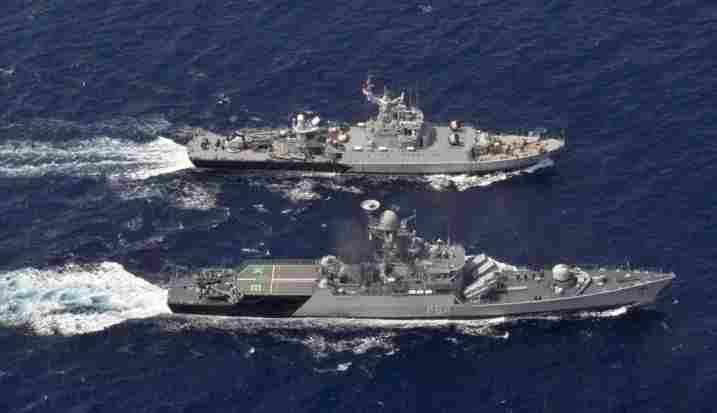Recently, INS Shivalik and Kadmat arrived in Jakarta, Indonesia, to participate in the third edition of the bilateral exercise “Samudra Shakti”. Where the armies of the two countries conducted this exercise in the Sunda Strait area from September 20 to September 22, 2021.
Significantly, the third edition of the Samudra Shakti exercise took place in a safe COVID environment and aims to strengthen maritime cooperation between the two navies and forge stronger ties of friendship throughout the Indo-Pacific.
Objective – Samudra Shakti
The purpose of the Samudra Shakti exercise is to improve mutual understanding and interoperability in maritime operations between the two navies and to strengthen bilateral ties. The exercise will also provide a suitable platform to share best practices and develop a common understanding of maritime security operations.
Participating ships and aircraft
The Indian side INS Shivalik and Kadmat are participating in the Samudra Shakti exercise, which is part of the Eastern Fleet of the Indian Navy based in Visakhapatnam under the Eastern Naval Command. At the same time, the Indian Navy’s P8I anti-submarine warfare long-range maritime reconnaissance aircraft is also participating in the exercise. KRI Bang Tomo, KRI Malahayti and the CN-235 maritime reconnaissance and patrol aircraft represent the Indonesian Navy.
Context – Samudra Shakti
The exercise “Samudra Shakti” was designed as a bilateral IN-IDN exercise in 2018. The Samudra Shakti exercise has advanced significantly in terms of the complexity of the exercise in the last two editions and includes the conduct of complex maritime operations, including military interdiction operations (MIO), cross landings, air defense series, weapons fire drills, refueling approaches and tactical maneuvers.
What is Samudra Shakti
The Indian Navy has conducted maritime power maneuvers with Indonesia under China’s nose. Samudra Shakti exercise is seen as important in stopping China’s growing reach in the Indian Ocean. In this exercise from September 20 to 22, the warships of the two countries showed their strength. This maneuver took place near the Sunda Strait, known as the gateway to the Indian Ocean.
There is a dispute between Indonesia and China over Natuna Island in the South China Sea. On the Indian side, INS Shivalik and Kadmat participated in the Samudra Shakti exercise. The Indian Defense Ministry issued a statement stating that the aim of this exercise is to increase mutual understanding and interoperability in maritime operations between the two navies. It will also strengthen the bilateral relations between India and Indonesia. The exercise will also provide a suitable platform to share best practices and develop a common understanding of maritime security operations.
Warships from India and Indonesia that Participated
The Indian Navy INS Shivalik warship is the latest locally designed and built multi-role guided missile stealth frigate. Other than that, the INS Kadmat is an anti-submarine corvette. These two warships are part of the Eastern Fleet of the Indian Navy based in Visakhapatnam under the command of the Eastern Navy.
The Indian Navy’s P-8I anti-submarine aircraft also participated in this exercise. KRI Bang Tomo, KRI Malahayati and the CN-235 maritime patrol and reconnaissance aircraft participated in Samudra Shakti exercise on the Indonesian side. Meanwhile, the navies of the two countries trained together to find and destroy the enemy submarine hidden in the deep waters.
Also Read : Malaysia revokes 5G contracts for 5 companies, Indonesia grabs China’s neck- Southeast Asia is taking on China
Sunda Strait surveillance will increase China’s troubles
The Sunda Strait is considered an important gateway to the Indian Ocean. If a Chinese ship or submarine is going to enter the Indian Ocean, it will have to enter the Sunda Strait in Indonesia or the Gulf of Malacca in Malaysia. The Gulf of Malacca is a busy trade route.
Many countries, including India, the United States, keep a close eye on this thin entrance. In such a situation, China can cross the Sunda Strait. But, now due to the maneuvers of the Indian Navy near this strait, China’s problems could increase dramatically in the coming days.
China’s relations with Indonesia are not good either. In such a situation, if a Chinese warship or submarine tries to enter the Indian Ocean via this route, it will be in the eyes of Indonesia. Thanks to this, it can be easy to follow this Chinese submarine.
China and Indonesia daggers drawn in the South China Sea
China and Indonesia have disputes over the South China Sea and the islands. In September, Indonesia removed a Chinese ship from its waters. Chinese flag fishing boats are frequently seen near Natuna Island.
These ships, supported by the Chinese government, are shipped with the Dragon claim. Chinese patrol officers are also deployed to protect them. After which Indonesia also increased the deployment of its navy in this area.
In late July, Indonesia carried out large-scale maneuvers near the island of Natuna. According to experts, Indonesia is rapidly increasing its capacity amid growing tension with China. 24 warships participated in Samudra Shakti exercise, including two guided missile destroyers and four escort ships.
China claims 90% of the South China Sea. It has disputes with the Philippines, Malaysia, Brunei and Vietnam over this sea. At the same time, the dispute between China over the islands and Japan in the East China Sea is at its peak. The United States has also rejected China’s claim on the South China Sea.
Also Read : Indonesia’s tallest leader Sukarno’s daughter is all set to do a Ghar Wapsi
